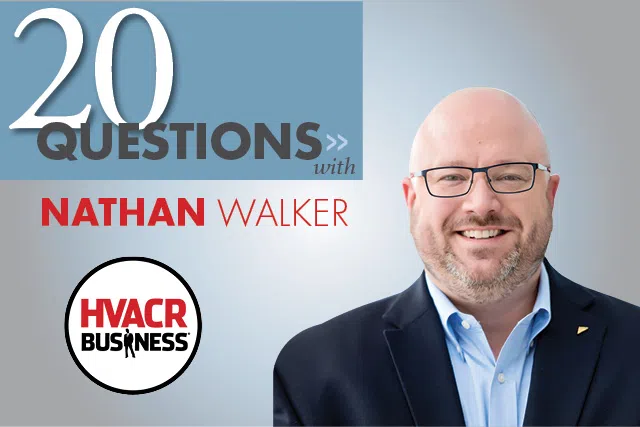We sat down with Nathan Walker, vice president of Goodman Manufacturing in Waller, Texas, to discuss industry refrigerant changes, specifically A2Ls and R-32, and how these changes will impact the North American market. We also discussed COVID-19 and opportunities for contractors focused on indoor air quality (IAQ).
1. When you’re at work, what always puts a smile on your face?
The extraordinary and outstanding efforts our employees provide to ensure we can continue to deliver the best support possible to our customers.
2. Please finish this sentence; I was raised to believe ...
... that you work hard on behalf of yourself and your family and that you lend a helping hand to others when they need it.
3. What’s your most recent good idea?
Recently, I’ve had a few but they are work related and proprietary. So, I can’t share them right now.
4. You studied engineering in college ... how did you transition into marketing?
I owe that fortunate shift in my career to good leadership at Goodman. After helping Goodman prepare for the 13 SEER transition, I was approached about a product management job that leveraged my technical experience in a way I had not considered at the time.
5. You’ve been with Goodman for 18 years ... what’s kept you at the company for so long?
Thank you for the subtle reminder of my age! Honestly, I came to Texas expecting to stay a short time and return to my native Tenn. However, I joined a fast-paced organization that was fiercely dedicated to serving its customers. I thoroughly enjoyed it from day one.
6. What do you see as the next significant change coming to the industry?
A refrigerant change is likely coming to the HVACR industry. Specifically, a low global warming potential (GWP) replacement for R-410A — it represents a significant change to everyone affiliated with the industry.
7. What benefits do A2L class refrigerants offer?
Many A2Ls offer lower GWP, single component versus blend, better capacity, efficiency and improved thermophysical properties.
8. Do you think there will be more than one refrigerant option available?
Yes, I am aware of two North American manufacturers that have announced their choice for an R-410A replacement, and they are not the same A2L class refrigerant.
9. Why has your company endorsed R-32?
R-32 is a proven commodity, deployed in more than 100 million units around the world. R-32 is abundant and widely available from multiple suppliers. As a pure, single-component refrigerant, R-32 can be topped off and recharged in the field, in both liquid and gas phases, without changes in composition. Further, R-410A is a blended refrigerant of 50 percent R-32.
10. What defines ‘mildly flammable?’
All A2L class refrigerants carry that distinction. But, R-32 refrigerant is roughly 100 times more difficult to ignite than propane.
11. Refrigerants are heavily regulated ... why is it so confusing for contractors?
When the industry goes through a refrigerant transition, I think inaccurate and misleading information confuses contractors. Often, rumors spread quickly, then eventually are proven wrong. In the meantime, contactors may make decisions that could be detrimental to their business.
12. How does the pending refrigerant change affect the North American market?
Quite often, a refrigerant transition creates the opportunity for manufacturers, and others to create new technologies that will help the industry deliver even more efficient and effective heating and cooling systems. From my perspective, the refrigerant transition is only one part of a continually evolving industry.
13. Do you think this will be the last refrigerant transition?
Likely not. We should remember this is the fourth major transition since the beginning of air conditioning. There may be changes in the future as new refrigerants are developed and guidelines change.
14. How can contractors benefit from changes that occur due to regulations?
Successful contractors understand they are in the service business, and equipment is just one component of the services they provide. A refrigerant transition offers enhanced energy savings and performance.
15. What are the biggest challenges for contractors when new refrigerant regulations are introduced?
Contractors are a resilient group. Typically, they adapt to any change that affects the industry, whether it involves new technology, refrigerants or energy efficiency standards. That’s what makes contractors unique.
16. Where can contractors get the most accurate information regarding refrigerant changes?
It depends on the change. For the pending refrigerant transition, equipment and refrigerant suppliers are the best source for accurate information. Industry associations such as Air Conditioning Contractors of America (ACCA), Institute of Heating and Air Conditioning (IHACI), Sheet Metal Air Conditioning National Association (SMACNA), Air-conditioning, Heating & Refrigeration Institute (AHRI) and Plumbing-Heating-Cooling Contractors — National Association (PHCC) are dependable sources for information too.
17: Where can contractors learn more about R-32 right now?
That’s easy. We developed a tool that answers 32 of the most commonly asked questions about R-32. Anyone can visit r32reasons.com. Its an informative and educational site devoted to R-32 refrigerant. For example, R32 can be up to 12 percent more efficient, it’s non-proprietary and it’s GWP is 68 percent lower than R-410A.
18. Beyond refrigerants, what trends do you see in the market over the next three years?
Control technology and connectivity seem to be a trend with HVACR equipment that will continue. The continued growth of ductless systems and inverter units is a trend that we’ll continue to see in the coming years.
19. It’s been a challenging year for contractors ... have you noticed positive trends that have helped them?
Many who are working from home are spending more time with their HVACR system and have discovered their current system is not providing the indoor comfort expected. Many contractors are getting calls to troubleshoot or replace systems that have received additional scrutiny due to owners spending more time at home.
20. Due to the COVID-19, has interest in indoor air quality (IAQ) increased?
The pandemic has reshaped attitudes of homeowners and business regarding IAQ. Beyond needing hot or cold air, a growing emphasis on the quality of the indoor environment is occurring.






